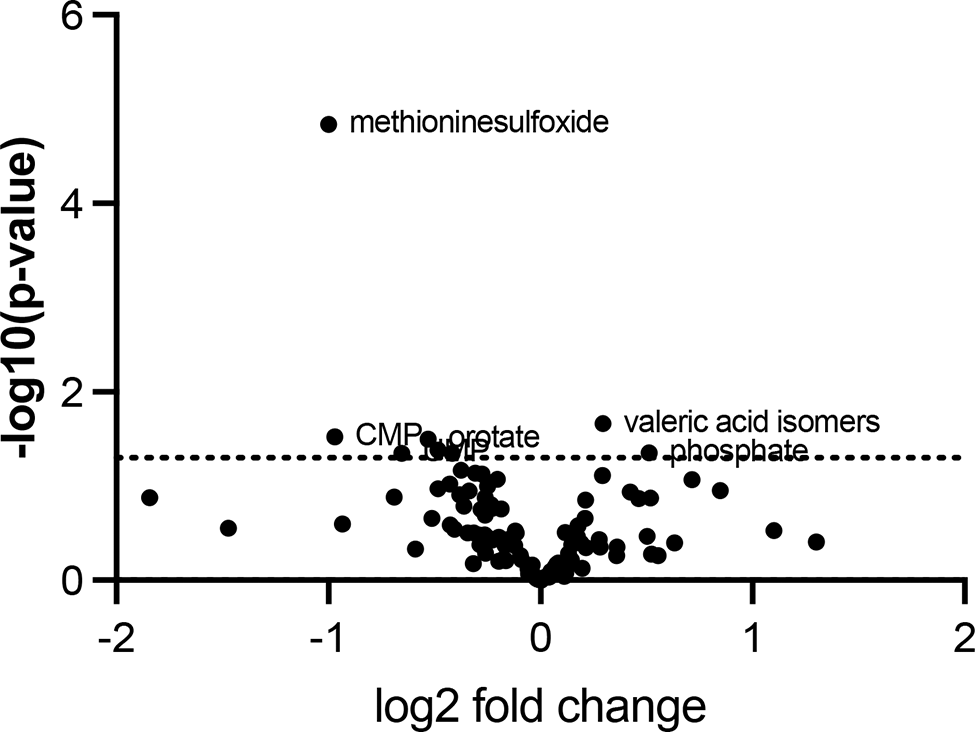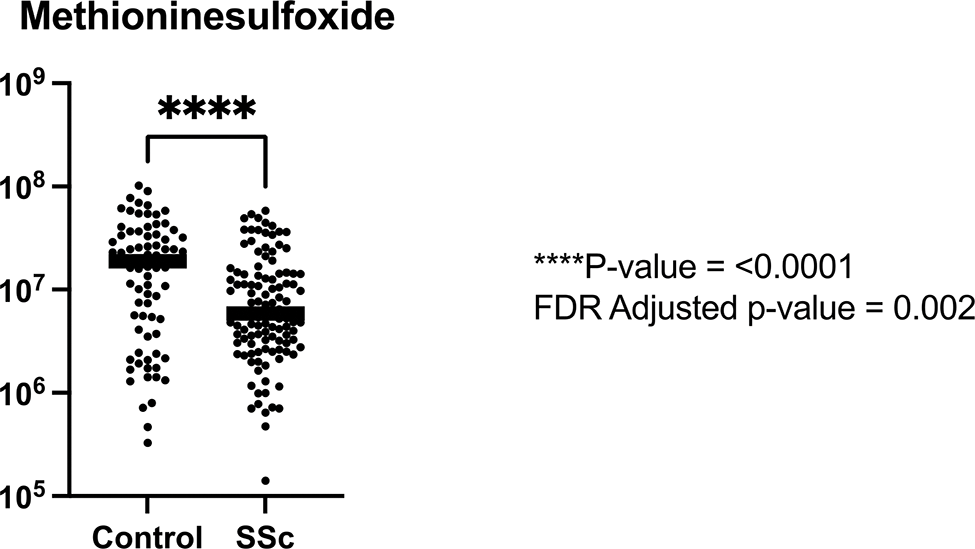

Background: The gastrointestinal tract (GIT) is the second most commonly affected organ system in systemic sclerosis (SSc), affecting 90% of patients. 1,2 Despite the high prevalence of GIT involvement, limited effective treatments for gastrointestinal manifestations of the disease exist, in part due to a lack of understanding of the factors that drive this disease process. Recent studies point to the gut microbiome as a potential key mediator in the pathogenesis and progression of GIT involvement in SSc. [3] One of the ways in which the gut microbiome may mediate its pathogenic effects is through the production of metabolites. However, no studies have investigated the fecal metabolome in patients with early SSc.
Objectives: To compare the fecal metabolome between patients with early SSc and unaffected controls (patients without GI or autoimmune disease).
Methods: Stool samples were collected from 115 patients with SSc with a disease duration of <3 years and 79 age-matched unaffected controls from a single center in Sweden. Samples were lyophilized and metabolites were extracted using methanol extraction buffer. Targeted metabolomic profiling was performed using liquid chromatography mass spectrometry. Raw peak areas were normalized to four internal standards to account for any variability between runs on the mass spectrometer. The difference in metabolite abundance between systemic sclerosis samples and healthy control samples was calculated as the Log 2-fold change (Log2 FC) and a Student’s t test was used to determine whether differences in metabolite abundances were statistically significant between SSc patients and unaffected controls. The False Discovery Rate (FDR) was used to correct for multiple hypothesis testing.
Results: The mean age of patients with SSc and healthy controls was 55.3 and 56.7 years, respectively. More women were present in the SSc group compared to the healthy control group (84.9% versus 69.4%). The median disease duration for patients with SSc was 2 years and the majority (67%) of SSc patients had never been exposed to any immunomodulatory therapy.
A total of 138 metabolites were detected across the dataset. We identified several fecal metabolites that differed significantly between SSc patients and unaffected controls (Figure 1). Metabolites that were enriched in the feces of patients with SSc included valeric acid isomers (Log2 Fc 0.29, P=0.02) and phosphate (Log2 Fc 0.51, P=0.04). Metabolites that were depleted in patients with SSc included methioninesulfoxide (Log2 Fc -1.0, P<0.0001), orotate (Log2 Fc -0.53, P=0.032), CMP (Log 2 Fc -0.97, P=0.030), and UMP (Log 2 Fc -0.65, P=0.045). After adjusting for FDR, the difference in methioninesulfoxide between groups remained statistically significant at a q-value of 0.002)(Figure 2).
Conclusion: Methioninesulfoxide was statistically significantly depleted in the feces of a cohort of early SSc patients compared to unaffected controls. Methioninesulfoxide is formed when methionine is oxidized by reactive oxygen species. Previous studies have shown a correlation between the gut microbiome and fecal metabolites in other diseases such as pulmonary fibrosis [4] and inflammatory bowel disease [5] . In future studies, we aim to determine whether certain metabolites such as methioninesulfoxide correlate with the abundance of specific bacterial genera and GIT symptoms in patients with SSc.
REFERENCES: [1] Zhu, J. et al. Curr Treat Options in Rheum (2019); 5, 11–19.
[2] Andréasson, K. et al. ACR Open Rheumatology (2022); 4 (5), 417–425.
[3] Plichta, D.R. et al. Genome Med (2021); 13, 35.
[4] Gong, G. et al. Life Sciences (2021); 264.
[5] Duboc, H. et al. Gut (2013); 62 (4), 531–539.
Difference in fecal metabolite abundance between patients with SSc and unaffected controls. Metabolites above the dashed line (-log10 p-value = 1.3) are considered statistically significant.

Methioninesulfoxide is decreased in fecal samples from SSc patients (median = 5.87x10 6 ) compared to unaffected controls (median = 1.89x10 7 ).

Acknowledgements: NIL.
Disclosure of Interests: Arissa Young: None declared, Kristofer Andréasson Johnson & Johnson Innovative Medicine, Nedas Matulionis: None declared, Blake Wilde: None declared, Jonathan Jacobs: None declared, Heather Christofk Pelage Pharmaceuticals, Faeth Therapeutics, Pelage Pharmaceuticals, Elizabeth Volkmann Boehringer Ingelheim, GSK, Boehringer Ingelheim, Prometheus, Horizon.